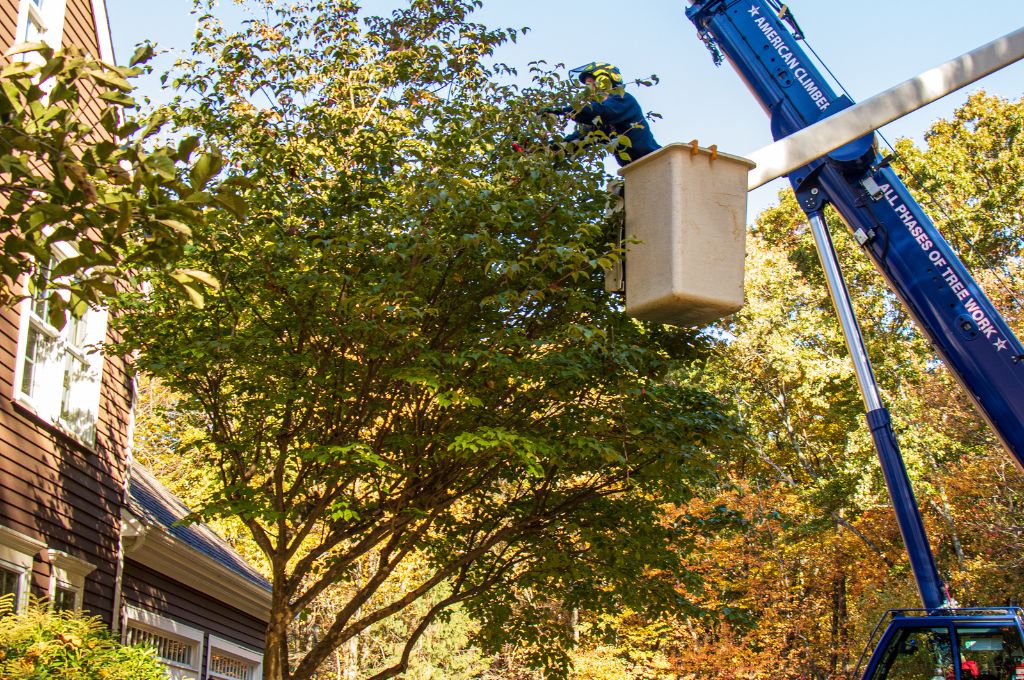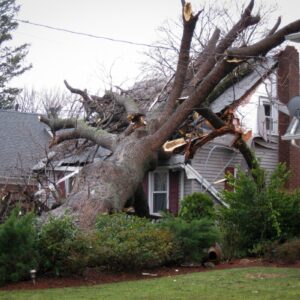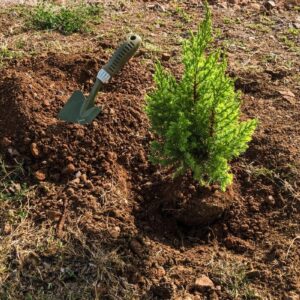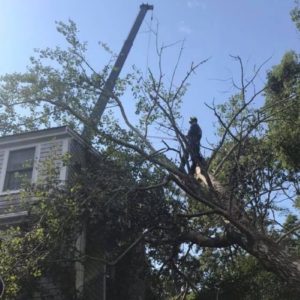Many property owners in Massachusetts contact us at American Climbers asking for “tree topping” for their trees.
However, tree topping is not a service that we (or any reputable tree care company) provide. People may ask for tree topping because:
- They don’t understand what the term means
- Other trees in the surrounding area were topped so it’s assumed that’s the correct method
- They don’t understand how bad topping is for trees
- They actually want tree reduction pruning or another tree service
In this article, we’ll go over why we don’t provide tree topping services, how tree topping can harm your trees, and what kinds of tree pruning and trimming we do offer.
Keep reading to learn more!
What is Tree Topping?
We go over it in more detail in this article about tree pruning mistakes to avoid, but tree topping is removing the top of a tree and more especially, cutting the tree’s main stem or trunk.
Tree topping was performed in the past (and sadly, is still done) with the thought that it would reduce the overall height of a tree.
How Does Tree Topping Harm Trees?
What happens when a tree is topped is that the tree becomes stressed from the pruning cuts and puts out weak but fast-growing branches called watersprouts. These weak branches are grown by the tree because its source of energy, the leaves from its tree canopy, were suddenly removed. Without those leaves, the tree has fewer leaves with which to perform photosynthesis.
Watersprouts are not a good look for a tree. And since they are fast-growing but weak, they can create a lot of litter when they break off due to high winds or storms.
They also tend to increase the overall height of the tree, and they need to be pruned more frequently than regular, healthy branches. So, the initial reason for topping the tree (reducing its height) becomes an issue again, leading to more bad pruning cuts and more watersprouts.
When a tree is topped, it loses its structure and stability. Topped trees never regain the strength that they had before the large, improper pruning cuts were made.
In some cases, topping a tree (especially if it is done more than once) can cause a tree to die a premature death.
The excessive pruning wounds, incorrect pruning methods, and the stress that it causes to the tree can become too much.
Alternatives to Tree Topping
Thankfully, when most people ask us to “top” their trees, this antiquated method is not actually what they had in mind.
Crown Reduction
Crown reduction pruning is helpful when a tree grows too tall or wide for the space in which it was planted. By using the proper crown reduction pruning methods, a tree’s overall size or spread is reduced. This is different from topping a tree because the main leader or trunk is not cut, and the pruning cuts that are made are planned so that the overall form and structure of the tree remain intact.
Crown reduction may also be used when a tree is getting too close to utility lines, a building, or other structures.
Crown Raising
Pruning a tree by raising the crown means removing select lower branches of a tree. Crown raising is usually done to provide access underneath a tree or to improve a view. Crown raising is usually done on younger trees rather than mature trees because the pruning cuts can become large (resulting in large wounds) when a tree is older, and the limbs are larger.
Crown Thinning
Some trees, such as fruit trees, need sunlight and airflow to flow through the tree canopy. Allowing more airflow through a tree is also thought to reduce some storm damage from high winds.
Crown thinning is when branches are selectively pruned out to increase airflow and light penetration throughout the tree’s canopy. While pruning to thin a tree’s crown, the branches being pruned away are carefully selected to maintain the tree’s shape.
Crown Cleaning
If you notice a lot of dead or broken branches in your tree, crown-clearing pruning may be the best option for you. Crown cleaning involves pruning away any branches that aren’t contributing to the health of your tree. Diseased branches or branches that are growing incorrectly are also included in this type of pruning.
Contact American Climbers for Tree Pruning and Trimming
Proper pruning is not only knowing how to implement the types of pruning mentioned above but also knowing how to make each cut with the purpose of helping the tree rather than hurting it. Making proper pruning cuts, using the correct tools, having the equipment to reach the canopy of tall or hard-to-reach trees, and knowing the best methods for going about the tree pruning job are all part of the job.
The American Climbers team follows ANSI A300 standards used by professional arborists. For tree pruning that allows your trees to be safe and healthy, contact American Climbers.
Homeowners may think topping is what they should ask for when they hire someone to prune their large trees – but it’s not.
Blog Topics
Recent Posts
What's Happening? Stay Informed!
Stay on top of local events, pest and disease updates, tree and landscape tips, and more. Delivered straight to your inbox each month.










